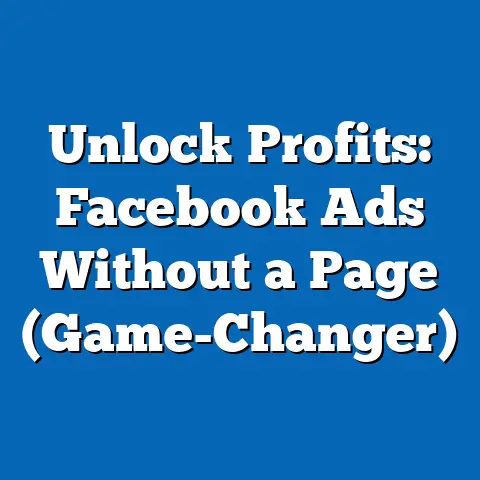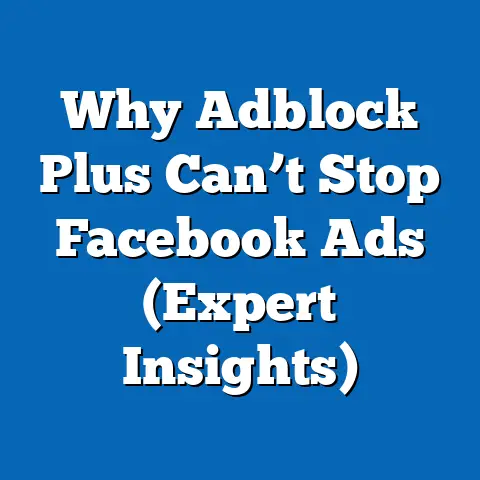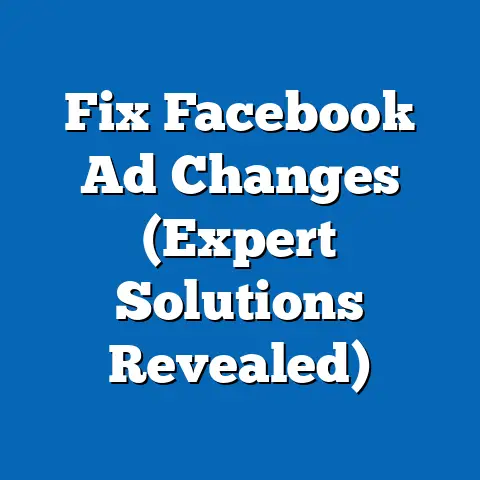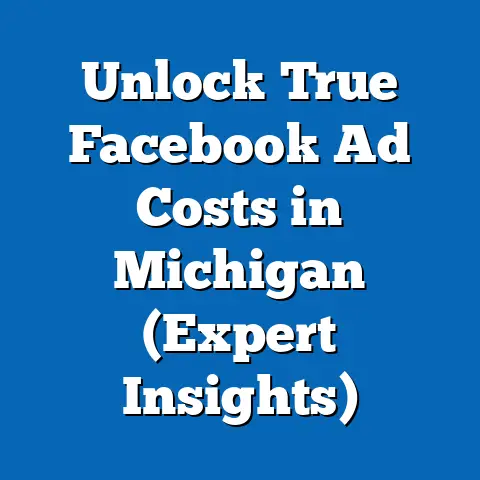Maximize Medical Practice with Facebook Ads (Expert Tips)
In today’s fast-paced world, patients aren’t just looking for medical care; they’re seeking convenience, accessibility, and a personalized touch. They want to book appointments online, access health information instantly, and feel understood by their healthcare providers. And where do they turn to find all this? Often, it’s social media, especially Facebook. That’s why I believe Facebook advertising is no longer optional for medical practices – it’s a necessity.
I’ve seen firsthand how a well-crafted Facebook ad campaign can transform a struggling practice into a thriving one. It’s about meeting patients where they are and providing them with the information they need, exactly when they need it. Think about it: someone experiencing sudden back pain might search for solutions on Facebook. If your orthopedic practice has a targeted ad showcasing your expertise in back pain relief, you’re immediately connecting with a potential patient at a crucial moment.
The numbers speak for themselves. Studies show that a significant percentage of patients research medical professionals and services online before making a decision. Facebook, with its massive user base and sophisticated targeting capabilities, offers an unparalleled opportunity to reach these potential patients. In fact, according to recent data, over 70% of adults use Facebook daily, making it a prime platform for healthcare marketing.
But simply running ads isn’t enough. To truly maximize your medical practice with Facebook ads, you need a strategic approach. This means understanding the platform’s nuances, crafting compelling content, targeting the right audience, and constantly analyzing and optimizing your campaigns.
Let’s dive in and unlock the potential of Facebook ads for your medical practice!
Understanding Facebook Advertising
Facebook advertising offers a unique blend of reach, precision targeting, and cost-effectiveness, making it an ideal platform for medical practices looking to expand their patient base. Unlike traditional advertising methods, Facebook allows you to connect with potential patients based on their demographics, interests, behaviors, and even their life events.
Overview of Facebook Ads
Think of Facebook as a giant, interactive billboard that you can customize to show your message to the right people. With over 2.9 billion monthly active users, Facebook boasts an unparalleled reach. But what truly sets Facebook advertising apart is its sophisticated targeting capabilities.
I remember working with a dermatology clinic that was struggling to attract new patients for their acne treatment services. We decided to launch a Facebook ad campaign targeting teenagers and young adults in the local area who had expressed interest in skincare, beauty products, or acne-related topics. Within weeks, the clinic saw a significant increase in appointment bookings, proving the power of targeted advertising.
Here’s why Facebook Ads are beneficial for medical practices:
- Vast Reach: Connect with a massive and diverse audience.
- Precise Targeting: Reach potential patients based on specific demographics, interests, and behaviors.
- Cost-Effectiveness: Control your budget and pay only for the results you want.
- Measurable Results: Track your campaign performance and make data-driven adjustments.
The demographics of Facebook users are also highly relevant to medical practices. While the platform is popular across all age groups, it’s particularly strong among adults aged 25-64, a demographic that often requires a range of medical services. This means you can target specific age groups, genders, income levels, and other demographic factors to reach the patients most likely to benefit from your services.
Types of Facebook Ads
Facebook offers a variety of ad formats, each with its unique strengths and ideal use cases. Choosing the right ad format is crucial for maximizing the impact of your campaign. Let’s explore some of the most popular options:
-
Image Ads: These are simple yet effective ads that feature a single image and accompanying text. They’re ideal for showcasing your brand, promoting specific services, or highlighting patient testimonials.
- Example: A pediatric practice could use an image ad featuring a smiling child and text highlighting their expertise in children’s health.
-
Video Ads: Video ads are highly engaging and can effectively convey complex information in a visually appealing way. They’re perfect for showcasing your practice’s facilities, introducing your staff, or providing educational content.
-
Example: An orthopedic practice could create a video ad featuring a patient testimonial about their successful knee replacement surgery.
-
Carousel Ads: Carousel ads allow you to showcase multiple images or videos in a single ad unit. They’re great for highlighting a range of services, showcasing different aspects of your practice, or telling a story.
-
Example: A dental practice could use a carousel ad to highlight their various services, such as teeth whitening, Invisalign, and dental implants.
-
Slideshow Ads: Slideshow ads combine multiple images or videos into a visually engaging slideshow format. They’re a cost-effective alternative to video ads and can be used to create a similar impact.
-
Example: A dermatology practice could use a slideshow ad to showcase before-and-after photos of patients who have undergone acne treatment.
Image Ads: These are simple yet effective ads that feature a single image and accompanying text. They’re ideal for showcasing your brand, promoting specific services, or highlighting patient testimonials.
- Example: A pediatric practice could use an image ad featuring a smiling child and text highlighting their expertise in children’s health.
-
Video Ads: Video ads are highly engaging and can effectively convey complex information in a visually appealing way. They’re perfect for showcasing your practice’s facilities, introducing your staff, or providing educational content.
-
Example: An orthopedic practice could create a video ad featuring a patient testimonial about their successful knee replacement surgery.
-
Carousel Ads: Carousel ads allow you to showcase multiple images or videos in a single ad unit. They’re great for highlighting a range of services, showcasing different aspects of your practice, or telling a story.
-
Example: A dental practice could use a carousel ad to highlight their various services, such as teeth whitening, Invisalign, and dental implants.
-
Slideshow Ads: Slideshow ads combine multiple images or videos into a visually engaging slideshow format. They’re a cost-effective alternative to video ads and can be used to create a similar impact.
-
Example: A dermatology practice could use a slideshow ad to showcase before-and-after photos of patients who have undergone acne treatment.
Video Ads: Video ads are highly engaging and can effectively convey complex information in a visually appealing way. They’re perfect for showcasing your practice’s facilities, introducing your staff, or providing educational content.
Example: An orthopedic practice could create a video ad featuring a patient testimonial about their successful knee replacement surgery.
Carousel Ads: Carousel ads allow you to showcase multiple images or videos in a single ad unit. They’re great for highlighting a range of services, showcasing different aspects of your practice, or telling a story.
Example: A dental practice could use a carousel ad to highlight their various services, such as teeth whitening, Invisalign, and dental implants.
Slideshow Ads: Slideshow ads combine multiple images or videos into a visually engaging slideshow format. They’re a cost-effective alternative to video ads and can be used to create a similar impact.
Example: A dermatology practice could use a slideshow ad to showcase before-and-after photos of patients who have undergone acne treatment.
When selecting an ad format, consider your campaign objectives, target audience, and the type of message you want to convey. Experiment with different formats to see what works best for your practice.
Takeaway: Facebook advertising offers a powerful way to reach potential patients. Understanding the platform’s reach, targeting capabilities, and various ad formats is essential for creating effective campaigns.
Setting Clear Objectives
Before diving into the technical aspects of Facebook advertising, it’s crucial to define your goals. What do you want to achieve with your Facebook ad campaigns? Are you looking to increase brand awareness, generate leads, promote specific services, or drive website traffic?
Define Your Goals
Setting clear objectives is the foundation of any successful marketing campaign. Without clear goals, it’s impossible to measure your progress or determine whether your efforts are paying off.
I once worked with a small family practice that was struggling to attract new patients. They were running Facebook ads, but they weren’t seeing any results. After analyzing their campaign, I realized that they hadn’t defined any specific goals. They were simply “trying to get more patients,” which is too vague to be effective.
We worked together to define specific, measurable, achievable, relevant, and time-bound (SMART) goals. These included:
- Increase brand awareness by 20% in the local community within three months.
- Generate 50 new leads per month for their primary care services.
- Promote their annual flu shot clinic and attract 100 new patients.
- Drive 1000 new visitors to their website per month.
Once they had clear goals in place, we were able to tailor their ad campaigns to achieve those specific objectives. This resulted in a significant improvement in their campaign performance.
Here are some common goals for medical practices using Facebook ads:
- Increase Brand Awareness: Reach a wider audience and establish your practice as a trusted healthcare provider in the community.
- Generate Leads: Collect contact information from potential patients who are interested in your services.
- Promote Specific Services: Highlight specific treatments or procedures that your practice offers, such as cosmetic surgery, dental implants, or physical therapy.
- Drive Website Traffic: Increase traffic to your website, where potential patients can learn more about your practice and schedule appointments.
Measuring Success
Once you’ve defined your goals, you need to establish a way to measure your success. Facebook Insights provides a wealth of data that can help you track your campaign performance and determine whether you’re on track to achieve your objectives.
Here are some key performance indicators (KPIs) that are relevant to medical practices:
- Reach: The number of unique people who saw your ad.
- Impressions: The number of times your ad was displayed.
- Click-Through Rate (CTR): The percentage of people who saw your ad and clicked on it.
- Conversion Rate: The percentage of people who clicked on your ad and completed a desired action, such as filling out a form or scheduling an appointment.
- Cost Per Click (CPC): The average cost you pay each time someone clicks on your ad.
- Cost Per Acquisition (CPA): The average cost you pay for each new patient or lead generated by your ad campaign.
- Return on Ad Spend (ROAS): The amount of revenue generated for every dollar spent on advertising.
By monitoring these KPIs, you can gain valuable insights into your campaign performance and make data-driven adjustments to improve your results. For example, if you’re seeing a low CTR, you may need to revise your ad copy or visual content. If you’re seeing a high CPC, you may need to refine your targeting options.
Takeaway: Setting clear objectives and measuring your success are crucial for maximizing the return on your Facebook advertising investment.
Identifying and Targeting Your Audience
One of the greatest strengths of Facebook advertising is its ability to target specific audiences based on a wide range of criteria. This allows you to reach potential patients who are most likely to be interested in your services.
Creating Patient Personas
Before you can effectively target your audience, you need to understand who they are. Creating detailed patient personas can help you visualize your ideal patients and tailor your ad campaigns to their specific needs and interests.
A patient persona is a fictional representation of your ideal patient based on research and data about your existing patients. It includes demographic information, such as age, gender, location, income, and education level, as well as psychographic information, such as interests, values, and lifestyle.
For example, a dermatology practice might create the following patient personas:
- Sarah, the Teenager: A 16-year-old female who is struggling with acne and wants to find a solution to clear her skin.
- John, the Young Professional: A 30-year-old male who is concerned about signs of aging and wants to explore options for wrinkle reduction.
- Mary, the Senior Citizen: A 70-year-old female who is interested in skin cancer screenings and treatment.
By creating these personas, the dermatology practice can tailor their ad campaigns to address the specific needs and concerns of each target audience. For example, they might create an ad campaign for Sarah that focuses on acne treatment options, an ad campaign for John that focuses on wrinkle reduction procedures, and an ad campaign for Mary that focuses on skin cancer prevention.
Utilizing Facebook’s Targeting Options
Facebook offers a wide range of targeting options that allow you to reach potential patients based on their demographics, interests, behaviors, and connections.
Here are some of the most useful targeting options for medical practices:
- Location Targeting: Target people who live in a specific geographic area, such as your city or county. This is particularly useful for practices that rely on local patients.
- Demographic Targeting: Target people based on their age, gender, education level, income, and other demographic factors. This allows you to reach specific patient populations, such as seniors, young adults, or families.
- Interest Targeting: Target people based on their interests, such as health, fitness, beauty, or specific medical conditions. This allows you to reach potential patients who are actively seeking information about your services.
- Behavior Targeting: Target people based on their online behavior, such as their purchase history, website visits, and app usage. This allows you to reach potential patients who have demonstrated an interest in healthcare products or services.
- Lookalike Audiences: Create a lookalike audience based on your existing patients or website visitors. This allows you to reach new potential patients who share similar characteristics with your best customers.
I’ve found that combining multiple targeting options can be particularly effective. For instance, a physical therapy clinic could target people who live in the local area, are aged 30-50, and have expressed interest in sports, fitness, or back pain relief. This would allow them to reach potential patients who are likely to be experiencing musculoskeletal pain and are actively seeking solutions.
Takeaway: Identifying and targeting your audience is essential for maximizing the effectiveness of your Facebook ad campaigns. Creating detailed patient personas and utilizing Facebook’s targeting options can help you reach the right people with the right message.
Crafting Compelling Ad Content
The content of your Facebook ads is just as important as your targeting. Even if you’re reaching the right people, your ads won’t be effective if they don’t capture attention and resonate with your audience.
Writing Effective Copy
Your ad copy should be clear, concise, and compelling. It should grab the reader’s attention, highlight the benefits of your services, and include a clear call to action (CTA).
Here are some tips for writing effective ad copy:
- Use a Strong Headline: Your headline is the first thing people will see, so make sure it’s attention-grabbing and relevant to your target audience.
- Highlight the Benefits: Focus on the benefits of your services, rather than just listing features. How will your services improve the lives of your patients?
- Address Common Concerns: Acknowledge and address common patient concerns, such as cost, pain, or recovery time.
- Use a Clear Call to Action: Tell people exactly what you want them to do, such as “Schedule an Appointment,” “Learn More,” or “Get a Free Consultation.”
- Keep it Concise: People are scrolling through their newsfeeds quickly, so keep your ad copy short and to the point.
I’ve found that using testimonials in your ad copy can be incredibly effective. Hearing from satisfied patients can build trust and credibility, making potential patients more likely to consider your services.
For example, a dental practice could use the following ad copy:
- Headline: Get a Brighter, Healthier Smile with Our Expert Dental Care
- Body: “I’ve never felt so confident about my smile! The team at [Dental Practice Name] is amazing. They made me feel comfortable and explained everything clearly. I highly recommend them!” – Sarah J.
- Call to Action: Schedule Your Appointment Today!
Visual Content Best Practices
Visual content is crucial for capturing attention on Facebook. High-quality images and videos can make your ads stand out and help you convey your message more effectively.
Here are some tips for creating compelling visual content:
- Use High-Quality Images and Videos: Avoid using blurry or pixelated images. Invest in professional photography or videography to create visually appealing content.
- Showcase Your Practice: Use visuals that showcase your practice’s facilities, staff, and equipment. This can help build trust and credibility.
- Use Real People: Use photos or videos of real patients (with their permission) to make your ads more relatable and authentic.
- Use Bright Colors: Use bright, eye-catching colors that will grab attention in the newsfeed.
- Keep it Simple: Avoid cluttering your visuals with too much text or information.
I’ve seen firsthand how a well-designed visual can dramatically improve ad performance. A physical therapy clinic that I worked with initially used stock photos in their ads. After switching to photos of their actual patients and therapists, their click-through rates increased by over 50%.
Takeaway: Crafting compelling ad content is essential for capturing attention and resonating with your target audience. Use clear, concise copy and high-quality visuals to make your ads stand out.
Budgeting and Bidding Strategies
Setting an appropriate budget and choosing the right bidding strategy are crucial for maximizing the return on your Facebook advertising investment.
Setting a Budget
Determining an appropriate budget for your Facebook ads depends on several factors, including your practice size, marketing goals, and target audience.
Here are some tips for setting a budget:
- Start Small: If you’re new to Facebook advertising, start with a small budget and gradually increase it as you see results.
- Consider Your Goals: How much are you willing to spend to achieve your marketing goals? For example, if you want to generate 50 new leads per month, how much are you willing to spend per lead?
- Use Daily vs. Lifetime Budgets: Daily budgets allow you to spend a fixed amount each day, while lifetime budgets allow you to spend a fixed amount over the entire duration of your campaign. Choose the option that best suits your needs.
I often recommend starting with a daily budget of \$10-\$20 and gradually increasing it as you optimize your campaigns. This allows you to test different targeting options and ad creatives without overspending.
Bidding Strategies
Facebook offers several different bidding strategies, each with its own advantages and disadvantages.
Here are some of the most common bidding strategies:
- Cost Per Click (CPC): You pay each time someone clicks on your ad. This is a good option if your goal is to drive traffic to your website.
- Cost Per Impression (CPM): You pay for every 1,000 impressions (times your ad is displayed). This is a good option if your goal is to increase brand awareness.
- Cost Per Action (CPA): You pay each time someone completes a desired action, such as filling out a form or scheduling an appointment. This is a good option if your goal is to generate leads or drive conversions.
The best bidding strategy for your practice will depend on your campaign objectives and your budget. I often recommend starting with CPC bidding and then switching to CPA bidding once you have enough data to optimize your campaigns.
Takeaway: Setting an appropriate budget and choosing the right bidding strategy are crucial for maximizing the return on your Facebook advertising investment.
Analyzing and Optimizing Campaign Performance
Once your Facebook ad campaigns are up and running, it’s important to monitor their performance and make data-driven adjustments to improve your results.
Monitoring Campaign Metrics
Facebook Insights provides a wealth of data that can help you track your campaign performance and identify areas for improvement.
Here are some key metrics to monitor:
- Reach: The number of unique people who saw your ad.
- Impressions: The number of times your ad was displayed.
- Click-Through Rate (CTR): The percentage of people who saw your ad and clicked on it.
- Conversion Rate: The percentage of people who clicked on your ad and completed a desired action.
- Cost Per Click (CPC): The average cost you pay each time someone clicks on your ad.
- Cost Per Acquisition (CPA): The average cost you pay for each new patient or lead generated by your ad campaign.
- Return on Ad Spend (ROAS): The amount of revenue generated for every dollar spent on advertising.
By monitoring these metrics, you can gain valuable insights into your campaign performance and make data-driven adjustments to improve your results.
Making Data-Driven Adjustments
Based on the data you collect, you can make a variety of adjustments to your Facebook ad campaigns to improve their performance.
Here are some common adjustments:
- Refine Your Targeting: If you’re not reaching the right people, refine your targeting options to reach a more qualified audience.
- Revise Your Ad Copy: If your ad copy isn’t capturing attention, revise it to be more clear, concise, and compelling.
- Update Your Visual Content: If your visual content isn’t engaging, update it with high-quality images and videos that showcase your practice.
- Adjust Your Bidding Strategy: If you’re not getting the results you want, adjust your bidding strategy to optimize for conversions.
A/B testing is a powerful tool for optimizing your Facebook ad campaigns. It involves creating multiple versions of your ads with different headlines, copy, visuals, or targeting options and then testing them against each other to see which performs best.
For example, you could create two versions of an ad for your dental practice, one with a headline that emphasizes teeth whitening and another with a headline that emphasizes preventative care. By tracking the performance of each ad, you can determine which headline resonates best with your target audience.
Takeaway: Analyzing and optimizing your campaign performance is essential for maximizing the return on your Facebook advertising investment. Monitor key metrics, make data-driven adjustments, and use A/B testing to continuously improve your results.
Conclusion
Facebook advertising offers a powerful way for medical practices to reach potential patients, increase brand awareness, generate leads, and promote specific services. By understanding the platform’s nuances, crafting compelling content, targeting the right audience, and constantly analyzing and optimizing your campaigns, you can unlock the full potential of Facebook ads for your practice.
I’ve shared my expert tips for leveraging Facebook ads to grow your medical practice, covering everything from the basics of Facebook advertising to advanced strategies for targeting, content creation, and campaign optimization.
Remember, the healthcare landscape is evolving rapidly, and patients are increasingly turning to online resources for information and solutions. Embracing Facebook advertising is not just about staying relevant; it’s about meeting your patients where they are and providing them with the care and information they need in a digital-first world.
So, take these expert tips, put them into action, and watch your medical practice thrive!





